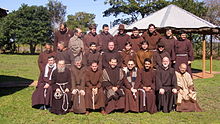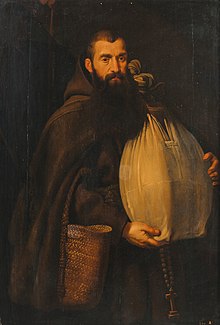Order of Friars Minor Capuchin
| Ordo Fratrum Minorum Capuccinorum[1] (Latin) | |
 Common Capuchin logo | |
| Formation | Founded: 1209 by St. Francis of Assisi and until the reformation aimed at regaining the original spirit of St. Francis and the Original Habit of St. Francis remained as the part of main branches. Capuchin Reformation started in 1525.[1] |
|---|---|
| Founder | St. Francis of Assisi Reformed as Capuchins by Matteo Serafini |
| Type | Mendicant Order of Pontifical Right (for men)[1] |
| Headquarters | Via Piemonte 70, Rome, Italy[1] |
Members (2020) | 10,349 (6,882 priests)[1] |
Minister General | Fr. Roberto Genuin, OFMCap |
Post-nominal initials | OFMCap |
| Website | ofmcap.org[1] |
The Order of Friars Minor Capuchin (
History
Origins


The Order arose in 1525 when
His
In 1528, Friar Matteo obtained the approval of
Rules of the Order
In 1529, they had four houses and held their first
The communities were to be small, eight being fixed as the normal number and twelve as the limit. In furniture and clothing extreme simplicity was enjoined and the friars were discalced, required to go bare-footed—without even sandals. Like the Observants, the Capuchins wore a brown habit but of most simple form, i.e. only a tunic, with the distinctive large, pointed hood reaching to the waist attached to it, girdled by the traditional woolen cord with three knots. By visual analogy, the Capuchin monkey and the cappuccino style of coffee are both named after the shade of brown used for their habit.[3][4][5]
Besides the
Early setbacks
At the outset of its history, the Capuchins underwent a series of severe blows. Two of the founders left it: Matteo Serafini of Bascio (
As a result, the whole province came under the suspicion of heretical tendencies and the Pope[specify] resolved to suppress it. He was dissuaded with difficulty, but the Capuchins were forbidden to preach.
Expansion
Despite earlier setbacks, the authorities were eventually satisfied as to the soundness of the general body of Capuchin friars and the permission to preach was restored. The movement then began to multiply rapidly, and by the end of the 16th century the Capuchins had spread all over the Catholic parts of Europe, so that in 1619 they were freed from their dependence on the Conventual Franciscans and became an independent Order. They are said to have had at that time 1500 houses divided into fifty provinces. They were one of the chief tools in the Catholic Counter-reformation, the aim of the order being to work among the poor, impressing the minds of the common people by the poverty and austerity of their life, and sometimes with sensationalist preaching such as their use of the supposedly possessed
The activities of the Capuchins were not confined to Europe. From an early date they undertook missions to non-Catholics in America, Asia and Africa, and a college was founded in Rome for the purpose of preparing their members for foreign missions. Due to this strong missionary thrust, a large number of Capuchins have suffered
Cimitero dei Cappuccini: The Capuchin Crypt
The crypt is located just under the Church of
The
What you are now, we used to be.
What we are now, you will be.[7]
Mark Twain visited the crypt in the summer of 1867, and begins Volume 2, Chapter 1, of The Innocents Abroad with five pages of his observations.
Modern era

Like all other Orders, the Capuchins suffered severely from the
In the
As of June 2018[update], there were 10,480 Capuchins worldwide, of whom 7,070 were
The worldwide head of the Order, called the
India
The Capuchin order, under the leadership of Italian Capuchin priest Giuseppe Maria Bernini, took part in the European colonization of India as missionaries and founded the community of Bettiah Christians.[9] Bernini was invited by Maharaja Dhurup Singh of the Bettiah Raj, an appointment that was approved by Pope Benedict XIV on 1 May 1742.[9]
United States

The United States has six provinces throughout the country. Together with the two provinces in Canada, the province of Australia and the Custody of the Mariana Islands/Hawaii they form the North American-Pacific Capuchin Conference (NAPCC).
Foundation
The Province of St. Joseph, originally the province of Calvary, headquartered in
One of the friars of this province,
As of 2011[update], the province has 23 communities spread throughout the
Other jurisdictions

- St. Joseph or Calvary (1882), based in Detroit, Michigan, covering the upper Midwest, from Detroit to Montana and from which came Blessed Solanus Casey.
- St. Augustine (1882), based in Pittsburgh, Pennsylvania, to which Cardinal Sean O'Malley belongs.
- Stigmata (ca. 1913), based in Miami, Florida.
- St. Mary of New York and New England (1952), based in White Plains, New York, with 18 fraternities on the East Coast, covering New England and New York. They supervise the Custody of Japan and the Custody of Guam.
- St. Conrad or Mid-America (1977), based in Archbishop of Philadelphia on 8 September 2011.[12]
- Our Lady of Angels (1979), Western America, based in Burlingame, California. Seven communities in California, with four communities in Mexico which became the Custody of St. Juan Diego in December 2011.[13]
- Star of the Sea Custody (1982), Hawaii and Guam, this division is dependent on St. Mary Province.
Capuchin Poor Clares
The
In the United States, as of 2012, there are five monasteries of this Order. There are about 50 nuns in these communities, which are located in: Denver and Pueblo in Colorado, Alamo and Amarillo (the first, founded 1981) in Texas, and Wilmington, Delaware. The monasteries were almost all founded from Mexico, where there are some 1,350 Capuchin nuns in 73 monasteries. The monastery in Pueblo is a foundation of the monastery in Amarillo. Together they form the Federation of Our Lady of the Angels.[14]
Appearance
The Capuchins are unique for a Catholic religious order in that the growing of natural, untrimmed
Saints and Blesseds



Saints
- Angelo d’Acri[15]
- Bernard of Corleone[15]
- Conrad of Parzham[16]
- Crispin of Viterbo[15]
- Fidelis of Sigmaringen[17]
- Federico da Berga & 25 Companions
- Felix of Cantalice
- Felix of Nicosia[18]
- Francis Mary of Camporossa[18]
- Joseph of Leonessa[16]
- Ignatius of Laconi[18]
- Ignatius of Santhià
- Leopoldo Mandić da Castelnuovo
- Lawrence of Brindisi
- Padre Pio of Pietrelcina
- Seraphin of Montegranaro
- Luca Antonio Falcone
Blesseds
- Anicet Kopliński
- Arsenio da Trigolo
- Benedetto da Urbino
- Bernard of Offida
- Diego José de Cádiz[16]
- Fernando Olmedo Reguera
- Geremia da Valacchia
- Giacinto Longhin
- Josep Tous Soler[17]
- Khalīl al-Haddād (Giacomo de Ghazir, Abuna Yaacoub) [19]
- Innocenzo da Berzo
- Leopold of Alpandeire[17]
- Marco d'Aviano
- Maria Maddalena Martinengo
- Nicola da Gesturi
- Honorat da Biała
- Solanus Casey
- Tommaso da Olera
Capuchin Poor Clares
Other notable Capuchins
- Jeremiah Benettis, 18th-century Italian writer
- Cesare Bonizzi, heavy metal band leader and singer
- Preacher to the Papal Household
- Charles J. Chaput, Archbishop of Philadelphia (2011–2020), Archbishop of Denver (1997–2011)
- Sebastian Englert, friar, archaeologist and ethnographer of Easter Island (1888–1969)
- Patri Fidiel, Maltese poet
- Henri de Grèzes, religious historian and writer
- Beatus Kinyaiya, Archbishop of Dodoma (2014–present)
- Seán Patrick O'Malley, cardinal, Archbishop of Boston (2003–present)
- Vinkenti Peev, Bulgarian priest
- Wolfgang Pisa, Bishop of Lindi (2022–present)
- sedevacantist
- Jude Thaddaeus Ruwa'ichi, Bishop of Mbulu (1999-2005), Bishop of Dodoma (2005-2010), President Tanzania Episcopal Conference (2006-2012), Archbishop of Mwanza (2010-2018), coadjutor Archbishop of Dar es Salaam (2018-2019), Archbishop of Dar es Salaam (2019–present)
- Antonio de Sedella, chief of the Spanish Inquisition in Louisiana (1788), rector of St. Louis Cathedral (1795–1829)
- Emerich Sinelli, Prince-Bishop of Vienna (1681–85)
- Yannis Spiteris, Archbishop of Corfu (2003–present)
- Dávid Bartimej Tencer, Bishop of Reykjavik (2015–present)
- François Leclerc du Tremblay, friar and politician referred to as "The Grey Eminence" (1577–1638)
References
Citations
- ^ a b c d e f "Order of Friars Minor Capuchin (Institute of Consecrated Life - Men) [Catholic-Hierarchy]".
- ^ a b c d e Chisholm, Hugh, ed. (1911). . Encyclopædia Britannica (11th ed.). Cambridge University Press.
- ^
Fragaszy; et al. (2004). The complete capuchin : the biology of the genus Cebus. Cambridge University Press. p. 5. OCLC 55875701.
- ^ Capuchin monkeys also have "hoodlike tufts of hair" on their heads. Entry, "capuchin" in The American Heritage Dictionary of the English Language (1976), Boston: Houghton Mifflin.
- ^ "The Culture of Italian Coffee". Archived from the original on 2011-03-05. Retrieved 2011-01-18.
- ISBN 978-0-88920-296-2
- ^ Capuchin Crypt Placard Archived 2008-10-22 at the Wayback Machine, Crypto Archeologico: Capuchin Crypts
- ^ statistical data from 'Analecta Ordinis Fratrum Minorum Capuccinorum, Roma
- ^ a b "Diocese of Bettiah". Union of Catholic Asian News. Retrieved 15 November 2020.
- ^ "FATHER HAAS'S LABORS IN WISCONSIN; The Introducer of the Capuchin Order in the United States" (PDF). The New York Times. 28 June 1895.
- ^ "Capuchin Franciscan Province of St Joseph". capuchins.org. Retrieved 2016-06-17.
- ^ "Capuchin Franciscans, Province of St Conrad". capuchins.org. Retrieved 2016-06-17.
- ^ "Capuchin Franciscans, Western America Province". capuchins.org. Retrieved 2016-06-17.
- ^ "The Capuchin Poor Clares". Retrieved 2016-06-17.
- ^ a b c "Saints and Blesseds". www.ofmcap.org. Retrieved Jan 11, 2023.
- ^ a b c ""Liturgical calendar", Capuchin Franciscan Friars, Province of the Stigmata". Retrieved Jan 11, 2023.
- ^ a b c "Capuchins". Capuchins. Retrieved Jan 11, 2023.
- ^ a b c "Capuchin Saints, Capuchin Franciscans, St. Conrad Province". capuchins.org. Retrieved Jan 11, 2023.
- ^ "Bl. Jacques Ghazir Haddad (1875-1954) - Biography".
- ^ "Poor Clares". www.capuchinpoorclares.org. Retrieved 2020-05-04.
Sources
- There does not appear to be any modern general history of the Capuchin order as a whole, though there are histories of various provinces and of the foreign missions. The references to this literature can be found in the article "Kapuzinerorden" in Wetzer und Welte, Kirchenlexicon (2nd ed.), a general sketch on the subject.
- Shorter sketches, with the needful references, are given in Max Heimbucher, Orden und Kongregationen (1896), i. §4 and in Herzog-Hauck, Realencyklopedie (3rd ed.), art. "Kapuziner."
- Helyot's Hist. des ordres religieux (1792), vii. c. 24 and c. 27, gives an account of the Capuchins up to the end of the 17th century.
External links
- Ordo Fratrum Minorum Capuccinorum, official website of international Religious Order
- Capuchins in Canada – Mary, Mother of the Good Shepherd Province, official website
- Capuchins of Ireland – Province of St. Patrick and St. Francis, official website
- Capuchins in Great Britain – Province of Our Lady Assumed Into Heaven and St. Lawrence of Brindisi
- Capuchin Franciscan Order – Our Lady of Angels Province, official website of Capuchin Franciscan Order in Western America
- The Capuchin-Franciscan Province of St. Joseph (Mid-West USA), official website
- Province of St. Joseph, official website
- Province of St. Conrad, official website
- Province of the Sacred Stigmata of St. Francis (New Jersey and Southeastern US), official website
- The Capuchin-Franciscans of the Province of Saint Augustine, official website
 This article incorporates text from a publication now in the public domain: Herbermann, Charles, ed. (1913). "Capuchin Friars Minor". Catholic Encyclopedia. New York: Robert Appleton Company.
This article incorporates text from a publication now in the public domain: Herbermann, Charles, ed. (1913). "Capuchin Friars Minor". Catholic Encyclopedia. New York: Robert Appleton Company.

